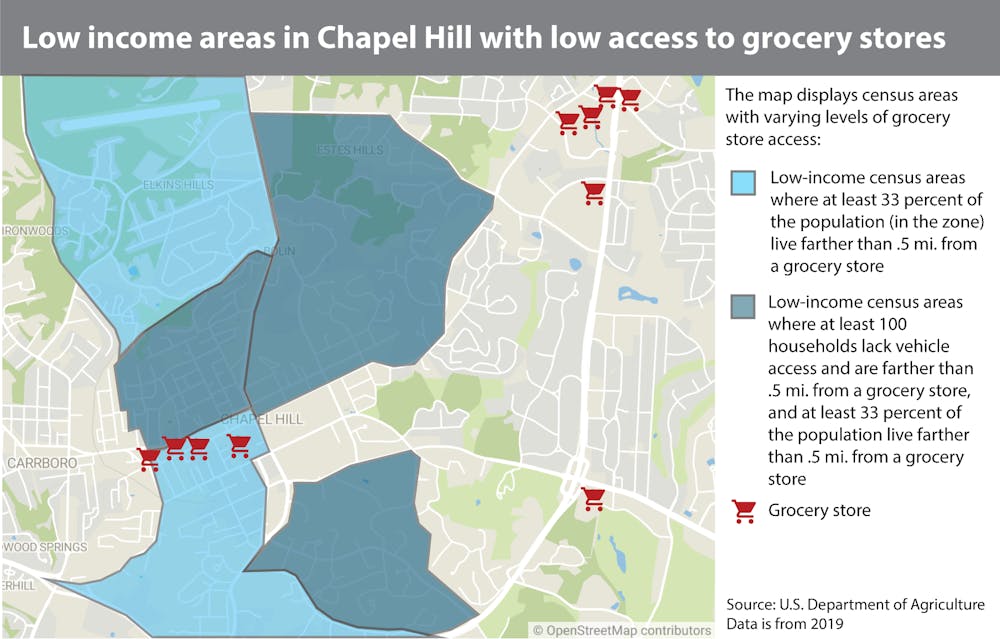One of these census tracts includes the area bordered by North Estes Drive, Martin Luther King Jr. Boulevard and East Franklin Street. The Franklin-Rosemary Historic District and the Estes Hill neighborhood are part of this tract.
According to 2019 data, 151 of 1,539 total households in that area did not have vehicles and are more than half mile from a grocery store.
Another tract's borders parts of West Rosemary Street and Umstead Drive — notably including the Northside neighborhood.
In this area of Chapel Hill, 125 of 1,161 total households did not have vehicles and are more than one-half mile from a grocery store — that's over 10 percent of households.
The third census tract includes UNC's middle, south and medical campus, bordered by South Road, South Columbia Street, Mason Farm Road and Fordham Boulevard.
Almost 20 percent of the total households in that area did not have vehicles and are more than a half mile from a grocery store.
The USDA also reports data about low-income areas where 33 percent of the population is more than a half mile in urban areas from the nearest grocery store. Areas that fall under this description in Chapel Hill include the aforementioned three tracts as well as two more areas reaching as far north as Homestead Road.
Since census data was last collected, ALDI and Wegman's have opened locations in Chapel Hill.
Barriers to healthy and affordable food
Many people must use public transportation, which can be unreliable, to get to grocery stores.
Inter-Faith Council for Social Service Director Kristin Lavergne said local public transportation is centered around the University and doesn’t provide access to those located in other parts of Chapel Hill.
“If people need to live on one side of town and the supermarket is on the other side of the town, more than likely they're going to have to take at least two buses and wait and time it all out,” Lavergne said. “And if you're working more than one job or you have children that you have to go pick up or all those things, that makes it more challenging.”
To get the day's news and headlines in your inbox each morning, sign up for our email newsletters.
Nate Broman-Fulks, affordable housing and community connections assistant director for the Town of Chapel Hill, said it has a "robust" transit system that can be useful in accessing food that isn’t available within walking distance. Chapel Hill Transit has also been fare-free for over two decades.
But Broman-Fulks said there are additional hurdles past just finding transportation to grocery stores.
A lack of affordability also makes food accessibility in Chapel Hill challenging, Berner said.
“The ability for a lot of folks to afford to stay where they live and then also have money left over to pay for their everyday essentials like food, clothing, that type of thing, is difficult for a lot of people,” Broman-Fulks said.
To address food insecurity, the Town of Chapel Hill has a food bank that distributes food to individuals every Wednesday at Eubanks Park and Ride lot. The Town also provides financial assistance through its Human Services Program to support programs addressing food insecurity including PORCH, Inter-Faith Council and TABLE.
Executive Director of TABLE Ashton Tippins said food insecurity in Chapel Hill has grown with increasing food, gas and housing costs.
Chapel Hill resident Shannon McCormick said he has been unhoused since 2014. He said he goes to the Inter-Faith Council in Carrboro to use its free lunch distribution every day and dinner distribution every weekdays.
“I’ve been homeless all for long since 2014, just glad you got somewhere you go to eat, shower,” he said.
While the Inter-Faith Council has been able to provide aid to residents like McCormick, Lavergne believes a long-term sustainable solution would be addressing root causes, like affordable housing. Berner said addressing financial accessibility to food means having conversations about how to eliminate poverty.
“It really becomes a question of looking at our own society and seeing how poverty actually constrains not only the poor, but it puts pressures, constraints on all sectors of our society,” Berner said. “And any solution is going to have to involve all sectors of society.”
@GowriAbhinanda
@DTHCityState | city@dailytarheel.com



